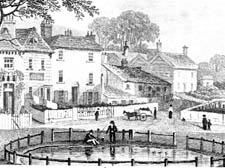|
|
 |
| |

South End Green
from the bottom of Pond Street, c1830 |
Battles in times past to keep the planners at bay
Belsize is the subject of a new history booklet. Dan Carrier hears how Katharine Whitehorn campaigned
to defend the area from town planners
Streets of Belsize, published by
the Camden History Society
AN ATTEMPT to drive a motorway through Swiss Cottage and Belsize Park was one of the best things that could have happened to the area, according to journalist and long-term Belsize resident Katharine Whitehorn.
Katharine, who next week helps launch Streets of Belsize, a Camden History Society publication which covers the life and times of the area by Hampstead historian Christopher Wade, first moved to NW3 in the mid-1950s. A columnist for the Observer for four decades, and author of a series of books including the seminal Cooking In A Bed-Sitter, she first lived in a top floor flat in Fitzjohns Avenue with her husband Gavin Lyall, which was owned by well-known Communist Anna Bostock.
“I fell in love with the area,” she recalls. “And it helped that Anna’s conscience was such that our rent never went up.”
But it was when town planners decided London of the future would best be served by running dual carriageways through north London that she truly began to know the place. She had recently moved to Provost Road, buying a house for £14,500, and suddenly the talk of the street was the threat of back gardens being compulsorily purchased, and lorries rumbling past windows day and night.
“It was called the North Cross Route,” she says. “It would have basically come through our back gardens. We quickly set up a motorway action group and it became the social focus of the neighbourhood.”
While her pretty, tree-lined street remains much the same as it was, the area has altered.
“There has been such a change of the area between Chalk Farm and Camden Town,” she says. “It used to be the most deserted road in London – there was one secondhand furniture shop, a plumbers’ store and Marine Ices – and they only sold ice cream back then. There was nothing for frozen grown-ups accompanying ice cream greedy children in mid-November.”
She recalls how Belsize Park was often overlooked by people who lived there. “If you were buying a house in the neighbourhood, you called it Camden Town,” she says, “and if you were selling, it became Hampstead.”
While Katharine remembers happy times in the area she has made her home, the Camden History Society book, which covers streets by placing them in a series of easy to complete walking routes, reveals some of the less savoury moments in the area’s history.
In 1704 the infamous Belsize pleasure gardens, land attached to Belsize House in Belsize Avenue, were opened to the public by an entrepreneur called Charles Povey. Povey offered a wed-wine-and-dine scheme, whereby he’d get you married in a Sion Chapel on his land for five shillings as long as you had your wedding feast in the gardens too.
The pleasure gardens also offered the chance to hunt wild deer, and horse racing – and plenty of secluded spots for racier past times. It quickly attracted prostitutes, followed by ruffians, so much so that Povey offered a “get you home service”. “There will be 12 stout fellows, completely armed, to patrol between London and Belsize,” his advertising bumph claimed.
The book includes many interesting asides, including an explanation for the mysterious round building next to Belsize Park Tube: it is an air shaft to the “Deep Shelter” built underneath the Tube and it stretches for a quarter of a mile from the Haverstock Arms to the Royal Free. It still has 9,000 steel bunk beds in place. Henry Moore was living in Parkhill Road during the war and sketched figures sleeping on the platform, avoiding the Blitz, while artist Milien Cosman also used figures seeking safety for her work.
The book, updated from a 1991 edition, is one of a series produced by the society which now covers every street in Camden. They are a superbly put together and are a fascinating record of the people who trod the pavements around us, the houses they lived in and the events they bore witness to.
|
 |
|
 |
 |
|
 |
|


